Pikes Peak 2023: The World's Most Dangerous Mountain Race Welcomes EVs to the Party
Compared to popular motorsport races like Formula 1 or Nascar, the Pikes Peak International Hill Climb can all too easily seem like a quick sprint up a mountain. But make no mistake, for race teams and drivers—even fans and spectators—Pikes Peak is a marathon that just happens to run on arguably the most dangerous road in America.
I arrived at Pikes Peak this year just after 3 a.m. on Thursday morning before Sunday’s race, after flight delays forced me to reroute into Denver. I drove straight to the mountain in the dark—only to find that a short spate of rain had canceled that morning’s practice and qualifying session. Fickle Colorado weather is always a big deal at Pikes Peak. Just watch the absolutely insane onboard footage of Robin Shute battling fog and wet roads last year as he drove his Wolf to an overall win almost entirely blind at times.
Even wandering around the pits on that first morning before heading down the hill to a catch some sleep at a hotel, I immediately discovered how Pikes Peak differs from other forms of motorsport. Among the racers and teams alike, a sense of camaraderie and community hits an entirely different level because, really, the enemies aren’t other drivers but rather the mountain, the weather, the road, and an intensified law of gravity.
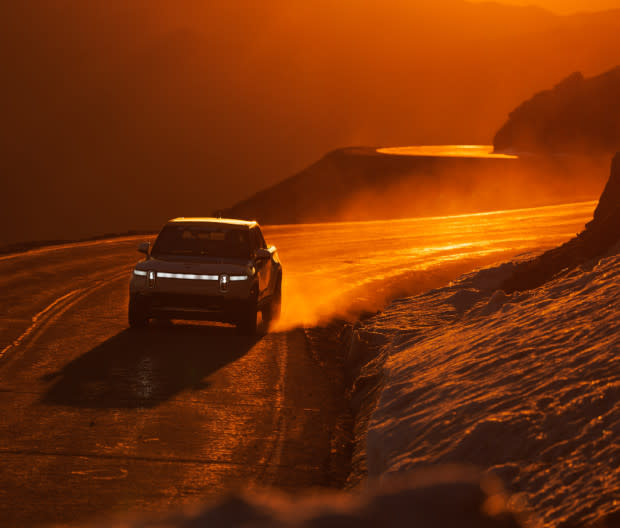
Larry Chen
An Electric Future Dawning at Pikes Peak
Gravity condenses air closer to sea level, so lower air density at the 14,115-foot summit of Pikes Peak presents problems for race cars that depend on oxygen to ignite with gasoline in the cylinders of internal-combustion engines. So when Volkswagen set a new 7:57.148 record time at Pikes Peak back in 2018 with the all-electric I.D. R racer, a new future for the hillclimb seemed inevitable.
This year, two privateer EVs arrived at Pikes Peak with eyes set on production vehicle records: a Tesla Model S Plaid built by Unplugged Performance with veteran Randy Pobst behind the wheel, and a Rivian R1T pickup truck prepped and driven by Rivian engineer and development driver (and Pikes Peak rookie) Gardner Nichols.
Ford also showed up with a factory-backed SuperVan 4.2 that logged impressive times in qualifying—not to mention producing plenty of stellar content. A 1,400-horsepower electric minivan bedecked in massive aero kit screaming by with sirens at full volume looked and sounded unlike anything else on the mountain. But Ford will never sell anything like the SuperVan to consumers, unlike the Tesla and Rivian that Unplugged and Nichols brought to the race.
Related: Rally Racing at Olympus Rally With Brandon Semenuk
Nichols charged his stripped and caged Rivian every morning from a nifty setup by Optima Batteries that tows behind another Rivian. The I.D. R might have set a seemingly untouchable back record in 2018, but no other EVs have gotten close, because where ICE cars lose power due to a lack of oxygen the higher up they drive, EVs gather heat in the batteries that then reduces power output.
And Nichols’ truck weighs 7,130 pounds—which means more power output required to race up the hill, which means more heat in the massive batteries while trying to beat the record production EV time of 11:06.205 set last year by Evasive Motorsports with a much lighter Tesla Model 3. I asked Nichols to explain the team’s strategy to combat the obvious problem of heat soak.
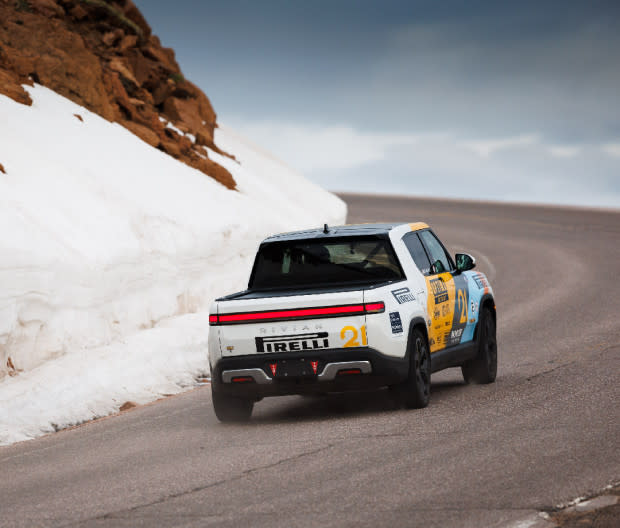
Larry Chen
“A lot of people are asking if we're gonna precondition the battery,” Nichols said, “I think we will. We're gonna try to get it as cool as we can. The battery's gonna get hot no matter what, so we're just trying to offset it as low as we can. Same thing with the motors. We're just gonna try to get everything nice and cool before race day, cuz the colder the car is, the better it'll be. If it's too cold, I might be a little torque limited off the start, but honestly that's totally fine. It's gonna heat up anyway.”
Nichols will also keep regen to the lowest factory setting, since even regen adds heat to the Rivian’s batteries. That means more reliance on the OEM brake setup, which resulted in a cracked rotor during practice on Wednesday.
Unplugged Performance also kept their car relatively stock other than a bit of extra aero and safety-mandated roll cage. But that’s the whole point, co-founder and CEO Ben Schaffer told me.
“We have a lot of respect for Tesla and, as a result, we don't really get into the batteries, the cooling, or the power output,” he said. “Ultimately, we're taking a family sedan, which is not really the optimum race car format to begin with. We're not really taking much weight out of it, because most of the weight's in the battery pack—and we're adding a huge roll cage and a bunch of things that weren't on the car. So, we're almost factory weight and factory power, with factory software. And we're here putting down similar lap times to cars like the 935 Porsche with slicks.”
Meanwhile, after setting the new production EV record last year, Evasive Motorsports returned to Pikes Peak this year with a fan-favorite Honda S2000 build driven once again by drifting champion Dai Yoshihara. The bright S2000RS almost took the cake for best style, though that honor undoubtedly went to a one-off carbon-bodied build from F1 World Champion Jenson Button and reality TV host Ant Anstead based on their Radford Motors Type 62-2.
In practice, Radford driver (also a drifting champion) Tanner Foust set down some pretty impressive segment times, but for race day, his team turned up the wick with a bit more power thanks to a new roof intake scoop and a set of straight pipes.
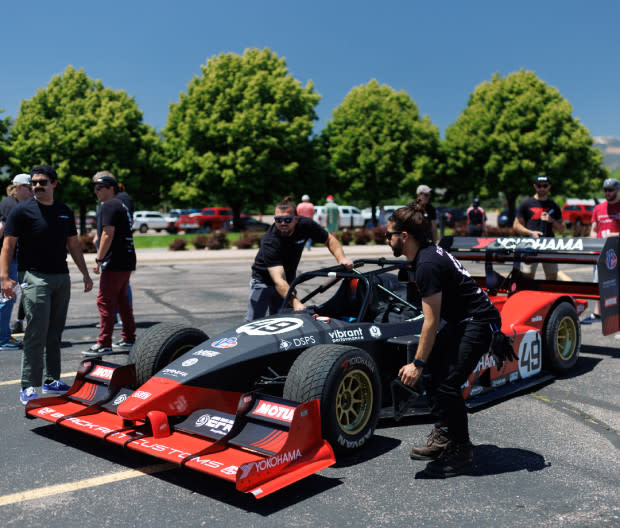
Larry Chen
The Internal-Combustion King of the Mountain
Robin Shute, on the other hand, might just be the epitome of a Pikes Peak story. His team, The Sendy Club, originally won Pikes Peak outright in 2019 on just his third attempt with a highly modified Wolf GB08 project that literally began in his garage. Shute’s open-wheeled Wolf focuses on low weight and aerodynamics—both essential for traction at speed and in the tight corners at Pikes Peak, where the car can manage 4g of lateral grip.
This year, The Sendy Club needed to get into race mode at the last minute because Shute wasn’t even supposed to be driving his own car.
“I was supposed to do the Aston Martin program,” Shute said. “Then that fell through. As cool as that was gonna be, and a great change for me, I’m really excited to have friends back and working on this car again. Got new people as well as old on the team. And then we've got lots of new friends in the racing community as well to share this with. I think that's why everyone always comes back, because this is the one event people do for the sheer challenge and enjoyment.”
Marginal gains make all the difference at Pikes Peak, but on a shoestring budget with engineering friends helping to build the Wolf, Shute needed to take a more prioritized approach focusing on big changes, rather than spending ages in a wind tunnel dialing in the aero package.
So the Wolf got a new turbo with an anti-lag system for this year’s race, as well as a massive new diffuser that needed to allow fitment of Yokohama Advan A005 tires from Japan’s Super Formula race series, and actually shifts the mid-engined car’s weight balance forward due to the Venturi effect. The end package weighs around 1,500 pounds with Shute and fluids, puts out an honest 650 horsepower at the crank (even at altitude), and can manage 4g of downforce.
Related: Ryan Reynolds and Rob McElhenney Buy Stake in Formula One Racing Team
Changes always result in unintended consequences, though—and three days before the race, The Sendy Club was trying to solve overheating issues caused by the new anti-lag system keeping hot air in the intake when Shute lifted off throttle, resulting in about 20 percent of boost lost. A water-sprayer system for the intercooler seemed to help, à la Subaru’s famous STI. Then, on Friday, a transmission shift barrel indexer failed and left Shute unable to downshift. Luckily, a friend with the replacement part flew in last-minute and the fix was relatively easy.
Also luckily, Shute had already qualified fastest by the time the gearbox issue cropped up. With the car ready to race, I asked how he focuses his mind knowing that any mistake at top speed pulling 4g, or a failure on the car, might well be his last.
“It's definitely a scary place,” Shute said. “You have to give it respect. Coming down the mountain and seeing all the places that you wouldn't want to go off is rough. But then once you're racing, it just requires your full focus and you can't think about anything else."
So I just focus on enjoying it. It's very special to be able to drive a car this fast on a mountain this gnarly. When race day comes, the jitters are always there, but I think I'm lucky that I'm able to harness those jitters and that adrenaline, and it really helps me focus and push for race day. So it's a process, it's exhausting, but it's also rewarding.”
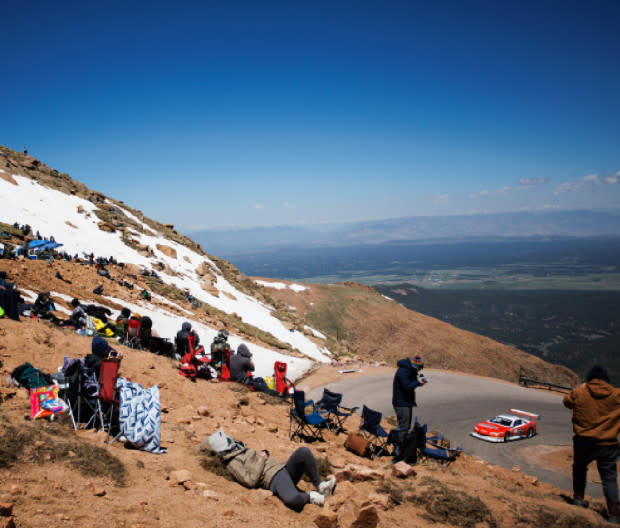
Larry Chen
Race Day Starts the Night Before
Sunday starts early for everyone at Pikes Peak. The race teams might even start late on Saturday night. Regardless, everybody wakes up and immediately checks the fickle Colorado weather. Qualifying determines the start order, but the lead-up to race day left many teams without a quality run on the lower, middle, and upper sections.
Most teams told me they wanted to run first to avoid potential weather rolling in later in the day. Then again, the first few cars up blow away any dirt or moisture on the road that might affect traction, while also scaring away wildlife that includes bighorn sheep and marmots—so running 10th or even 20th might actually be ideal.
I woke up at 12:30 a.m. and drove up to the mountain to catch a few more hours of sleep parked in the rental Suburban, rather than waiting around in the massive line of spectators who might spend those hours inching slowly up to the start line parking lot. Seemingly everyone who turned out at Friday evening’s Fan Fest in nearby Colorado Springs jams up the mountain on Sunday morning.
By the time I stumbled out into the hectic scene just before sun-up, starving and desperate for coffee, most teams already had grills and griddles roaring, cooking up breakfast burritos and egg sandwiches. Temps were cold, but the clear sky already hinted at a beautiful day on the hill. The best day in years, everyone kept saying. Maybe one for the record books.
Related: The Best Auction Sites for Finding Your Dream Car or Truck
For media, even attempting to cover Pikes Peak on race day presents a huge challenge. Only race cars can drive the single road, so I faced the choice of either driving up to a predetermined spot in advance and staying there for seven or eight hours, or sticking around the start line and pits—then hiking on foot up through the forest once the action begins.
I had driven the hill twice leading up to race day, once with Bimmerworld driver James Clay (in a BMW X3, not his 1,400-horsepower “E36” race car) and once in the Suburban. Photos and videos simply can't do justice to how sketchy this race truly is—all tight hairpins and steep drops, snow and rocks right up to the edge of the pavement near the top, and oftentimes terrible visibility even on a clear day,
Only insane people would drive this mountain at speed. Even with roll cages and fire suppression systems, this is the most dangerous race on the planet (other than the Isle of Man TT, since Pikes Peak banned motorcycles after the 2019 death of Ducati rider Carlin Dunne).
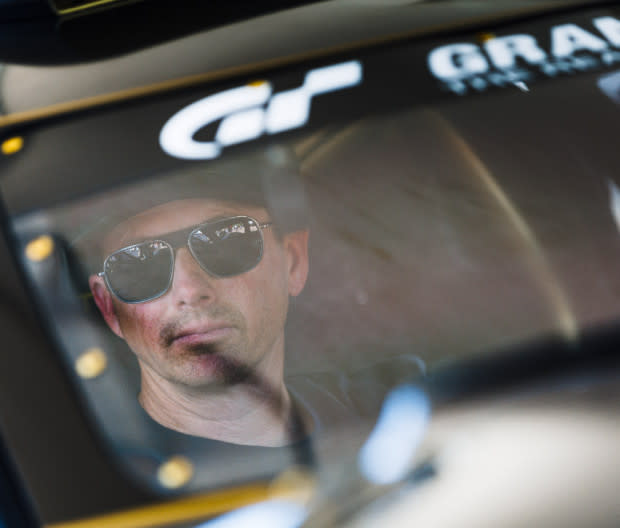
Larry Chen
Who Would Want to Race Here?
Speaking with Tanner Foust before he climbed into the Radford on race day, the community and camaraderie on display once again entered the chat.
“My first year, I never even thought about where I was placing with other cars,” Foust said. “Even now, after doing it a few times, everyone gives you advice on things that they never would at a regular track day. Tire pressures. How to take certain corners. How to avoid certain bumps ...
“The most daunting competitor you have is gravity—and the elements of the mountain and yourself,” he added. "Then, a distant third or fourth are the other competitors on the track. So it does make for a bit of a family. Everybody here knows that they're risking a lot and so there's something there. I get outreach from friends, family, and fans before a race like this more than any other—just because I think people respect the danger. It makes it a special event.”
Once the first cars pull up to the start line, at 9,000 feet of elevation, the mood in the pit turns tense. Warmup revs echo through the trees and smiles evaporate from faces. Time to get serious. After a spec class of Porsche Caymans put on by Yokohama Tires, the real race begins when Shute pulls up in the Wolf.
Where the EVs charge up to 100 percent, he’s only got 7.5 gallons of E85 on board and the run will require around 6.5 gallons. That’s not much wiggle room for warming up and idling before the green flag, or a potential restart due to a crash or wildlife incident up the road.
Betting big on a clean run, Shute launches hard off the line, Honda engine screaming at redline and banging upshifts through to the flying start line. Then he’s gone, and the Ford SuperVan pulls up in ominous silence. I take a hike up the through the forest and catch each car screaming by for only a split second, tires squealing, aero whooshing, and either that EV whine or peppery engine pop breaking through the otherwise pastoral woodland scene.
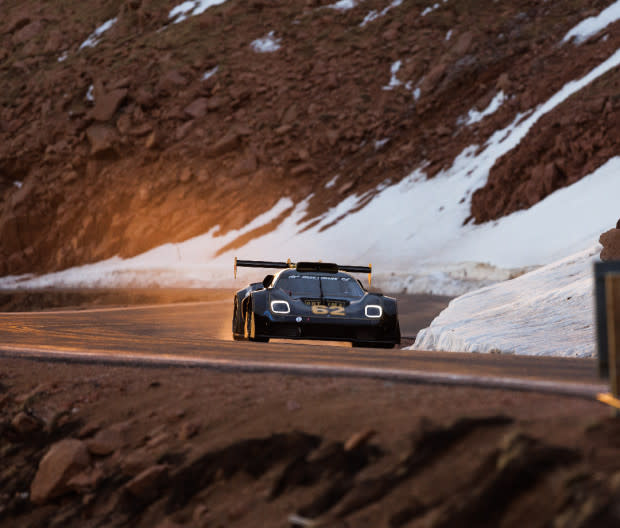
Larry Chen
After an Alpine A110 factory car and a few more Porsches pass by, I run back down to check times on a TV screen set up next to the start line. Shute managed an 08:40.080 while struggling with more downshift issues after initially cutting half a second off the I.D. R's 2018 time up to Engineer's Corner. Ford and the SuperVan finish next at a tight 8:47.682 and Foust, in the souped-up sexy Radford, comes in nearly a minute back with a time of 9:37.326.
Back up into the forest I head, where a four-rotor Mazda absolutely blatters by. Race order starts to blur. What have I seen pass and what’s still to come? Then sirens, a big emergency truck rushes by followed by an ambulance. Oh, no.
Half an hour later, the mangled carcass of a BMW XM also gunning for a production vehicle record rolls down the hill on a flatbed. At least nobody was hurt, but BMW’s tent cleans up and just about evaporates, despite setting the production car record with an M8 earlier in the morning.
I love watching the old 996-generation Porsches, whether original Turbos or not, flying by with engines rasping at full throat. A midget car with a burbling V8 and a massive wing on top almost matches the sheer volume of a former Nascar Camaro. The Evasive S2000RS hustles by, but ends up retiring. A bunch of home-built open-wheeled cars fly up the hill, too, but none can come anywhere near Shute’s time.
The day wraps with Lia Block driving the loosely-Porsche-based Hoonipigasus up the hill as a tribute to her father, the late, great Ken Block who helped boost Pikes Peak’s visibility in a big way with the famous Climbkhana video.
All the cars that successfully survive the challenge and make it to the top spent hours, depending on start order, waiting at 14,115 feet. Luckily, a visitor center makes donuts—as in fried dough, not burnt rubber. Then they all parade back down the hill, before beverages and a party down in Colorado Springs.
The officially-too-long race name is actually “The Broadmoor Pikes Peak International Hill Climb brought to you by Gran Turismo,” but the event is also known as The Race to the Clouds. The mountain itself goes by the nickname “America’s Mountain,” after U.S. Army brigadier general and explorer Zebulon Montgomery Pike discovered a massive peak formerly worshipped by indigenous populations as a location for spiritual vision quests.
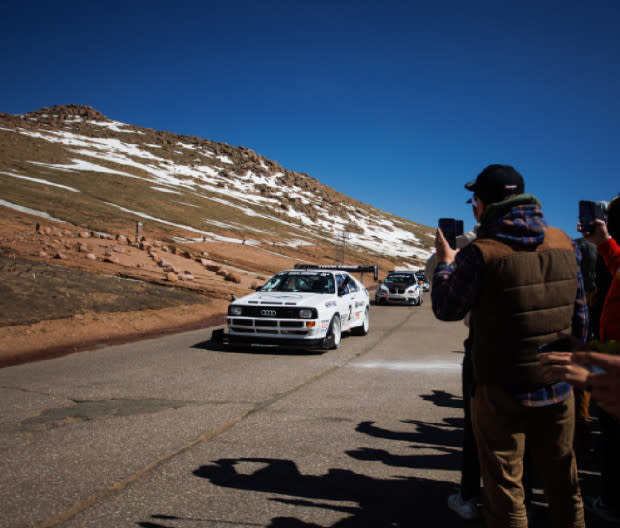
Larry Chen
What would it take to beat Volkswagen’s longstanding record, or even Sebastien Loeb’s best ICE time of 8:13.878 set in a Peugeot 208 T16? Shute wants to build a clean-sheet tube-frame race car not based on the Wolf. Ford will probably need to ditch that sweet van body to improve aero around the 1,400-horsepower EV platform.
Unplugged set a new production-based EV record of 9:54.901 with the Model S Plaid this year—an eternity behind the I.D. R, but only one second off the all-time-best production vehicle time set by a Porsche Turbo S, albeit not at an official running of Pikes Peak.
Alpine’s third-place finish in a modified A110 came as a surprise. Why is a French manufacturer racing on America’s Mountain? Turns out, on Monday after the race, Alpine will reveal plans to enter the U.S. market in 2027 with an A110 successor.
Pikes Peak offers a grand spectacle—man versus nature and physics in a race that belies comprehension. Television or online coverage might allow for more time spent watching the actual racing action, but misses out on the real-world context necessary to comprehend the sheer cliffs, tight hairpins, oxygen deprivation, and community spirit that make Pikes Peak special. Wandering through the forest trying to catch every race car rushing by, the pivot to electrification seems all the more important. For the moment, though, internal combustion still, if just barely, rules the mountain.
